Another uplifting football moment courtesy of the women who play, officiate and support the game.
Tag: women
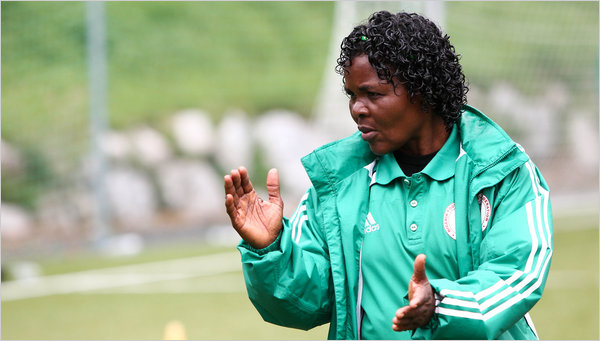
The New York Times today has a piece by Jere Longman about homophobia in the Nigerian team about to play in the 2011 Women’s World Cup. While it’s nice to see the newspaper of record in the U.S. paying attention to the women’s game and to African women in particular, the overall thrust of the article is that homophobia is an example of the “cultural obstacles that remain for many African women who play soccer.”
The story focuses on a single character: head coach Eucharia Uche. A former player and fervent evangelical Christian, Uche claims to have “used religion in an attempt to rid her team of homosexual behavior,” describing the latter as a “dirty issue,” and “spiritually, morally very wrong.”
There are several problems with the article, but I’ll focus on two key ones: (1) blaming “culture,” and (2) African “exceptionalism.” Let’s tackle the first one. While “cultural inhibitions are still cited as inhibitions to girls playing” notes Martha Saavedra’s seminal 2003 overview of the African women’s game published in Soccer and Society, “the general economic troubles and the lack of resources overall is still perhaps the most serious hindrance. Even the bans on women’s football in Northern Nigeria may be indirectly linked to this.” Yes, cultural conservatism (not “culture”) is a factor in some areas, but this does not necessarily apply to all of Nigeria, let alone all of “Africa” as the article’s headline suggests.
This reductionism leads to my second point: African exceptionalism. The first thirteen paragraphs of the article create the impression that homophobia is a singularly “African” issue. It is only in the 14th paragraph that some de-exoticization finally takes place: “The treatment of lesbians in sport is not a matter restricted to women in Africa. Some women on previous United States national soccer teams have been reluctant to live openly gay lifestyles for fear of repercussions.” Surely, American readers of the Times would have been quite interested to learn more about the existence of a “culture” of silence and repression in elite U.S. soccer. It might even invite a comparison with the grim situation in Uche’s squad.
The lack of discussion about women’s football in Nigeria is puzzling as well. The article contains not a single reference to the rich history of the game in Africa’s most populous nation. As I write in African Soccerscapes, women in Nigeria were playing as early as 1943. The 20 October 1943 issue of the Nigerian Spokesman newspaper ran this story:
In response to the demand of the people of Onitsha, the Sierra Leonean friendly Society has started to make arrangements for the replay of the ladies’ football mach which so thrilled the township recently. Good news for football enthusiasts . . . It was the first of its kind to be staged in Onitsha.” Fine show but not up to the standard of boys soccer. “It seemed odd to some to see our women in shorts kicking a football about the field, or clashing with one another after the manner of men . . . but the game itself, when it came to be played, exploded all the fantastic theories some malevolent individuals had concocted about it, and it was a colossal success both in the fun that it provided and on the financial side of it.
By 1960 (Nigeria’s independence) there were women’s teams in Jos, Lagos, Calabar, Onitsha, Kanu, Enugu and other towns. By 1989 there were 28 women’s clubs active, as well as a Nigerian Female Football Organizers Association. This history is vital to gaining a sharper understanding of the Super Falcons’ continental dominance since they first represented Africa at the WWC in 1991.
Let’s hope that future U.S. media coverage of the 2011 WWC will be more informed and more tightly focused on the game itself. The fans deserve it. The players deserve it. Football deserves it.
Indi’s Freestyle
Indi Cowie — a 16-year-old soccer phenom from North Carolina — can freestyle with the best. “The family garage is her laboratory,” notes the New York Times Magazine. “There are times when there’s an enormous bang and I wake up at 5 in the morning thinking there’s an intruder in the house,” says Indi’s father, Logan Cowie. “Then I realize it’s just Indi practicing her latest trick.” Interestingly, Indi plays with a boys’ club team rather than with her high school’s girls’ team. Would she rather be the best freestyler or the best soccer player in the world, she answers: “You mean I have to pick one? I can’t. Both.” Read the full article here.
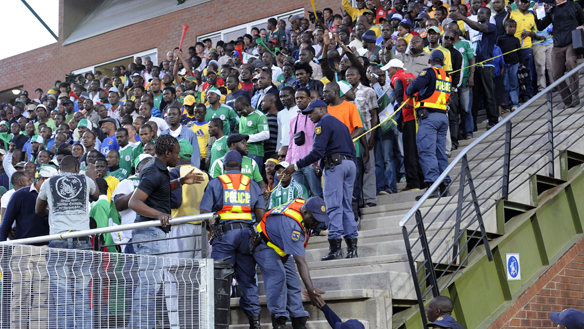
The stage is set for the most riveting match of the African Women’s Championship group stage. Tomorrow (November 4) South Africa take on perennial champions Nigeria. It is a battle between Africa’s powerhouses and fierce rivals. A decade ago, Banyana Banyana and the Super Falcons teams met in an ill-fated AWC final at Vosloorus Stadium, about an hour’s drive from this year’s venues.
On Saturday, November 25, 2000, at least 25,000 spectators packed into the modest Vosloorus stadium. A reporter in attendance described what happened (City Press, 26 November 2000, p. 1):
“The trouble started after unruly, hotheaded Banyana supporters exploded in anger and frustration when Nigeria got their second goal with 18 minutes left on the clock. Local fans considered the goal illegitimate. With Nigeria comfortably up 2-0 in defence of their title, the hotheads started to vent their anger at the assistant referee on the eastern side of the stadium by hurling an assortment of objects, including beer bottles and stones at her. The besieged assistant, in fear of her life, raised her flag to indicate her plight to Cameroonian referee Akono Ondo. Then she sprinted to the safety of the western side, where the other match officials were.
Shortly after this, more objects rained incessantly onto the pitch, clearly aimed at the Nigerians. The situation got further out of control when Nigerian supporters were forced to scurry in all directions in a death-defying scramble from the eastern stands.
Pandemonium broke out when South African and Nigerian fans began hurling abuse and anything they could lay their hands on, including rocks, shoes and umbrellas, at each other. The besieged fans made up largely of many children had to run helter-skelter to avoid the life-threatening stampede. Some of the children were seen tumbling from high up in the stands as the panic-stricken crowd ran in all directions.
The high tension was taken to breaking point by irate fans who constantly pelted the Nigerian players with an array of dangerous objects, thus preventing the match from restarting. Confused match officials, including Safa’s Oliphant and its general manager Dennis Mumble, appealed for calm in the stadium. [. . .]
Once it became evident the game would not resume under the hail of missiles, aimed mainly at the stunned Nigerian players, the embattled officials reluctantly abandoned the game, much to the delight of the Nigerians. As the victors merrily paraded around the field with their trophy, the anarchy and confusion spread to outside the stadium, where wayward fans fought pitched battles.
In the process, police reinforcements came under attack when their vehicles were stoned by a rampaging mob.”
South Africa’s widely celebrated hosting of the 2010 World Cup suggests that a repeat of the violence of 2000 is highly unlikely. However, rampant xenophobia and a 50 percent poverty rate provide kindling that can be ignited by the sparks of football passion and the game’s paradoxical quality to unite while it divides. Check back here for my match report of the Super Falcons – Banyana clash.
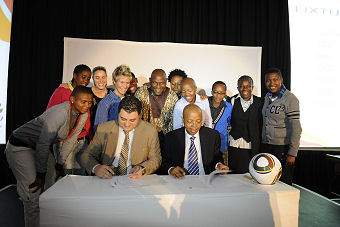
The draw for the 2010 African Women’s Championship was held yesterday at the Birchwood Hotel in Ekurhuleni, east of Johannesburg. The official schedule released by CAF and SAFA reveals that matches will take place at Daveyton’s Sinaba Stadium and Tembisa’s Makhulong Stadium from 31 October to 14 November 2010. However, it remains unclear where each match is taking place and what the kickoff times are.
South African media covered the draw in perfunctory fashion. Local officials repeated platitudes heard daily during the 2010 World Cup: the tournament will market Brand South Africa, foster unity and pride, and so on. ‘This is yet another opportunity to put South Africa and Africa on the global map,’ said Ekhuruleni councillor Ndosi Shongwe in a typical remark. ‘We will be calling all our people to rally behind Banyana Banyana in the same way we did for Bafana Bafana during the 2010 FIFA World Cup. Bafana united us as a nation, now let’s allow the Women’s National Team to take over the baton. To us this is more than just winning the trophy; it is about uniting the country towards social cohesion,’ Shongwe added.
The bigger and more important question, however, is: what will be the impact of this tournament on the development and growth of South African (and African) women’s football at junior, amateur, and elite levels?
This is a crucial question given that the number of female players — mostly black — continues to grow alongside their ongoing marginalization and exclusion in a male-dominated football world. (Suggested reading: Prishani Naidoo and Zanele Muhoi, ‘Women’s bodies and the world of football in South Africa,’ in Ashwin Desai’s The Race to Transform: Sport in Post-Apartheid South Africa (free download here)
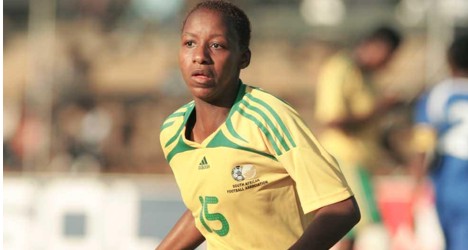
CAF announced that the final draw for the 2010 African Women’s Championship in South Africa will take place in Ekurhuleni (Gauteng) on 21 September. The tournament runs from 29 October to 14 November, with Equatorial Guinea (defending champions), Cameroon, Nigeria, Ghana, Algeria, Mali, Tanzania and hosts South Africa to be divided into two round-robin groups. The top two teams from each group advance to the semis.
But with barely a month to go we are still in the dark about where and when matches will take place. This inexcusable delay makes it more difficult for fans and media to participate in and cover the premier event in women’s football on the continent.
Meanwhile, South Africa’s women’s team, Banyana Banyana, lost 0-2 at home to Cameroon in its last match. Mail and Guardian blogger Siphiwe Hlongwane characterized it as ‘another painful reminder of how far behind we still are when it comes to the women’s game.’ Commenting on South Africa’s humiliating 10-1 loss to Germany in the Women’s Under 17 World Cup, my good friend Thabo Dladla noted in his column today: ‘You cannot have a national U17 team while girls are not playing football in primary school.’
Whether it’s properly hosting a major tournament, building competitive national teams, or developing youth football, for meaningful change to happen, as Hlongwane says, ‘Women’s football needs to be treated with respect.’
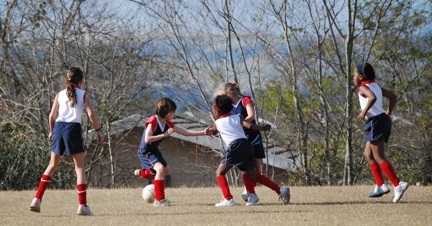
Remember ‘Feel it! It is here!’ and similar emotional tugs on our football-loving hearts and souls during the 2010 World Cup? A few weeks later, the country is due to host the CAF African Women’s Championship and the silence is deafening.
Media, the South African FA, government and the private sector are back to their usual ways, ignoring everything but the money-spinning elite men’s game. The most recent evidence of the continuing low status of the women’s game in South Africa (and Africa) is that the venues for the African Women’s Championship in October have yet to be decided.
After the World Cup, we are back to reality. Maladministration, commercial disinterest, and male condescension continue to hold African women’s football back. The more things change, the more they stay the same.